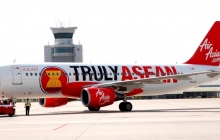AirAsia was launched in 2001 with the dream of making flying possible for everyone. Since then, AirAsia has swiftly risen to become the world’s best...
-

Fisheries
Where to invest?
Fisheries
The industry of fishing plays a vital role in the lives of millions of people in ASEAN and in the world. It is a main source of food and livelihood for many. It accounts for a significant percentage in global trade of agriculture commodities. Fish and marine products are among the most traded goods globally, with demand and supply both growing substantially since the last decade.
The world’s fish net
Fisheries production in Southeast Asia shows a stable quantity increase trend from 2016 to 2019, with an average annual increase of 0.5%. The increase in production value is more varied, with an average annual increase of 5.0%. There was a slight decrease in both quantity and value of production in 2020.
Indonesia was the largest fisheries producer in Southeast Asia in 2020, contributing 47.2% to the total quantity production. Vietnam ranked second (18.7%), followed by Myanmar (13.0%), the Philippines (9.5%), Thailand (5.2%), Malaysia (3.9%), and Cambodia (2.0%). Indonesia's dominance is also evident in production value, with a contribution of 51.8%.
Aquaculture is the largest subsector, accounting for 54% of the total quantity production in 2020. Marine capture fisheries contributed 39%, and inland capture fisheries 7%. In terms of value, marine capture fisheries accounted for 51%, aquaculture 41%, and inland capture fisheries 8%.1
More fish on plates
Global demand for the region’s fish produce is rising as other countries depend more on ASEAN’s catch. Australia sources nearly half of its fish demand from ASEAN countries. Studies show Australia’s domestic fish requirement will reach 776,000 tonnes by 2020. Of this volume, 610,000 tonnes will be imported.
In 2022, Thailand succeeded as the world's second-largest exporter of processed fish, with a value reaching $3.1 billion. This product ranked 21st on Thailand's list of most exported goods.
The United States ($751 million) was the top destination, followed by Japan ($355 million), Australia ($270 million), Egypt ($176 million), and Canada ($142 million). The fastest-growing markets were the US ($150 million), Australia ($74.3 million), and Libya ($67 million).2
Prioritizing fisheries
The fisheries industry is among ASEAN’s 12 priority integration sectors. A roadmap on the integration of the fisheries was developed focusing on four areas: food safety issues, research and development, human resources development, and information sharing. It seeks to strengthen regional integration through liberalisation and facilitation measures in fisheries trade and investment. A well-implemented roadmap will mean improved transport of fish products across borders.
Beyond fisheries production and trade, however, ASEAN Member States have also been implementing measures aiming to ensure sustainability of fish stocks. Efforts include the establishment of an inter-governmental body that develops modern fishery techniques and promotes responsible technologies and practices for sustainable fishing; conduct of biological studies on commercially-important fish species; conservation and management of aquatic species under international concerns, i.e., marine turtles and sharks; development of a regional Sustainable Development Strategy for the Seas; supporting non-government organization initiatives for the seafood resources of Southeast Asia; among others.
-
The fisheries industries include the marine sub-sector covering both commercial and small-scale fisheries; inland capture fishing which are carried out in rivers, lakes, swamps, and reservoirs; and coastal and freshwater aquaculture.
SUCCESS STORIES
-
- Site Map
- Terms & Abbreviations

